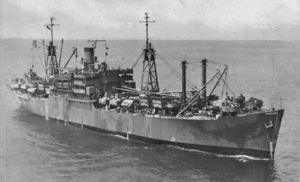USS Wheatland (AKA-85)
 Tolland class AKA, similar to USS Wheatland Tolland class AKA, similar to USS Wheatland | |
| History | |
|---|---|
| Laid down: | 17 July 1944 |
| Launched: | 21 September 1944 |
| Commissioned: | 3 April 1945 |
| Decommissioned: | 25 April 1946 |
| Struck: | 8 May 1946 |
| Fate: | Unknown |
| General Characteristics | |
| Hull Type: | C2-S-AJ3 |
| Displacement: | 8,635 tons light, 13,910 tons loaded |
| Length: | 459 ft 2 in (140 m) |
| Beam: | 63 ft (19.2 m) |
| Draft: | 26 ft 4 in (8.0 m) |
| Propulsion: | GE geared steam turbine drive, single propeller, 6,000 shp (4.5 MW) |
| Speed: | 16.5 knots (30.6 km/h) |
| Complement: | 395 (62 officers, 333 men), plus embarked troops |
| Armament: | 1 × 5"/38 caliber DP gun, 4 × twin 40 mm AA guns, 16 × 20 mm AA guns |
| Boats: | 14 LCVP, 8 LCM |
| NOTES: Some sources report different displacements for ships of this type. Speed and complement may have changed as the ship or her mission were modified. Often one or two LCVPs were replaced by LCPLs. 20mm AA guns were sometimes removed. | |
USS Wheatland (AKA-85) was a Tolland class attack cargo ship named after Wheatland County, Montana. She was designed to carry military cargo and landing craft, and to use the latter to land weapons, supplies, and Marines on enemy shores during amphibious operations. She served as a commissioned ship for 12 months.
History
Wheatland was laid down on 17 July 1944 at Wilmington, North Carolina, by the North Carolina Shipbuilding Company under a Maritime Commission contract (MC hull 1397); launched on 21 September 1944; sponsored by Miss Shirley B. Anderson; transferred to the Navy on 6 October 1944; converted to an attack cargo ship in New York by the Atlantic Basin Iron Works; and commissioned on 3 April 1945, Commander Attilio A. Vischio, USNR, in command.
Commissioned two days after the beginning of the last amphibious operation of World War II, the Okinawa invasion, Wheatland never saw service in the role for which she had been converted. Instead of operating as an attack cargo ship during amphibious assaults, she spent her brief Navy career laboring as a conventional cargo ship and as a troop transport in support of the occupation of former Japanese possessions.
Following shakedown training and amphibious exercises at Hampton Roads, Va., and post-shakedown availability at the Norfolk Navy Yard, the ship departed the Chesapeake Bay on 7 May with 5,038 tons of dry cargo. Steaming in company with USS Begor (APD-127), USS Cavallaro (APD-128), USS Lee Fox (APD-45), and USS Roberts (APD-94), she set a course for Hawaii (U.S. state). Parting company with the high-speed transports at Panama, she transited the canal on 14 May and continued her voyage to Oahu independently. She arrived in Pearl Harbor on the 28th and immediately unloaded her cargo. The ship remained in the Hawaiian Islands for three weeks, during which she conducted a series of amphibious exercises at the island of Maui.
On 21 June, she departed Pearl Harbor with elements of the Army's 9th Corps embarked. After stops at Eniwetok and Ulithi, she arrived at Leyte in the Philippine Islands on 7 July. There, she disembarked the troops and unloaded much of her cargo. On 9 July, she moved to Samar Island, where she discharged the remainder of her cargo. From there, she moved to the Palau Islands, departing Samar on the 16th and arriving at Angaur on the 18th. She spent the next two days loading a Marine Corps antiaircraft unit and, on the 21st, got underway to return to Oahu.
After a brief stop at Eniwetok for fuel on 26 July, she arrived in Pearl Harbor on 1 August. She discharged her cargo and disembarked her passengers and then began an availability which lasted until 22 August. On the 23d, she moved to [Hilo] where she began embarking elements of the 5th Marine Division. She returned to Pearl Harbor on the 27th and remained there until 1 September when she got underway for Sasebo, Japan, in company with a 34-ship convoy. She made a three-day stop at Saipan along the way and arrived at Sasebo early on the 22d. She discharged her cargo over the next three days and departed Sasebo on the 25th.
Wheatland entered Subic Bay in the Philippines on 30 September and, the next afternoon, moved to Lingayen Gulf where she loaded men and equipment of the Army's 32d Division for transportation to Japan. On 9 October, she stood out of Lingayen Gulf on her way to Kyūshū, Japan. The attack cargo ship arrived in Sasebo early in the morning of 16 October and began disembarking the troops later in the day. Returning to the United States via Okinawa and Guam, Wheatland arrived in Seattle, Wash., on 13 November. Later that month, she visited San Francisco, California for two weeks before embarking upon a voyage to the Northern Mariana Islands on 13 December. She arrived at Guam on the 28th and later visited Saipan whence she departed the Northern Mariana Islands on 22 January 1946. Steaming via the Panama Canal, the ship arrived in Norfolk, Va., on 21 February. She made one more voyage in her naval career—a round trip to New York and back to Norfolk between 28 February and 5 March—before beginning inactivation preparations at Norfolk.
Wheatland was placed out of commission at Norfolk on 25 April 1946, and custody was transferred to the War Shipping Administration. Her name was struck from the Navy list on 8 May 1946.
References
- Dictionary of American Naval Fighting Ships (Primary source for this article)